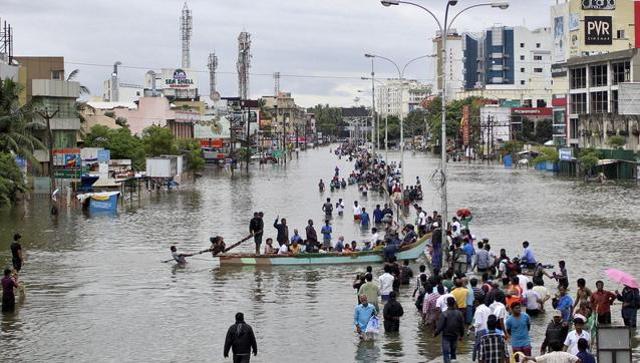Written by : Aditya Koppula Source (Pic) : Hindustan Times
Aftermath of Chennai Floods has not only left with bitter memories , life changing situations , rage on government in media and some inspirational stories shared in social networking sites but also a lesson re-told in more devastating way. Had the “Spirit of Chennaites” been vigorous and frisky before witnessing this havoc, it could have taken less lives (rather no lives), days and time to overcome the nature’s fury.
It is well known fact that the careless actions of humans have accelerated the extreme conditions in weather. Though the term Global Warming is well embedded in the minds of every educated person living in the “Smart Cities”, you would expect the least action from them to be responsible addressing Global Warming in their day to day lives. Distinct design and composition of urban areas like Chennaicompared to rural areas alters Climate Change impacts in cities leading to many diverse challenges. If you look Chennai with your naked eye, it is visible that over 75 percent of the city is covered with impervious surfaces such as buildings, concrete or asphalt, where the soil is ‘sealed’. Cities may be flooded if the water cannot drain quickly into the ground and the sewage system in cities cannot cope with the amount of water. As more than three quarters of surface area of Chennai is sealed, water did not disperse into ground during heavy rainfall. According to the magazine Business Standard “The drain-off system in Chennai, a city of millions, was originally planned for a population of 650,000. The Cooum and Adyar rivers are rarely dredged and their floodplains have been encroached upon. A recent study in Current Science estimates that more than half of Chennai's wetlands have been rendered useless by development; the 150 water bodies in the city serving as catchment areas have been reduced to 27. Dramatic reductions in green cover - almost wiped out in some municipal wards - mean that the ground cannot retain water; this increases water run-off by almost 90 per cent in some areas.”
Not only Chennai, the above explained statistics and situation is more or less the same in many major cities in India. For Governments to realise, understand and change the designs of the cities and invest in adaptation measures it will take a life time of people of my age. Rather than to wait for them make this possible and grew more despondent, it takes few extra minutes of your daily routine that helps prevent us to face such situation in the future. Here are few points that “you” could do:
- Love to take your fancy bike every time you step out of your home? Well, you are making yourself culprit of contributing to climate change. You may think that your contribution to Air Pollution may not harm anyone. In real, such mistakes began to take far more serious consequence when all the individuals taken together. Each person may contribute only a tiny fraction of the overall levels of pollutants in the environment, but bears the full cost of the population. What you should do: Walk or Ride a Bicycle or Use Public Transport as much as you can.
- Do you know that “Chennai loses 1,500 trees each year to illegal felling, developmental work or natural disasters according to environmentalists and other surveys”? This is an officially recorded figure. If you still have a question in your mind, on how on earth plants can combat such catastrophe, here it is; In a nutshell, the theory behind climate change or global warming is that increasing greenhouse gases are causing a general warming over the earth that is affecting global climate. Carbon dioxide in the atmosphere certainly has increased, and a consensus have emerged amongst scientists, policymakers, and citizens that warming and climate change is occurring. To reduce carbon dioxide build up and its effects on climate change, we can either reduce carbon dioxide emissions (mainly burn less fossil fuels as discussed in above point), or we can re-absorb carbon dioxide from the air. Trees enter the picture here because they can be used to take carbon dioxide out of the air. All plants make food out of carbon dioxide from the air, water, and solar energy through the process of photosynthesis. This food is then used to make most of the body of the plant, including roots, leaves, stem or trunk, and flowers and fruit. Well, all you need to do is plant more trees and stop cutting trees.
- If you are in an impression that floods may occur next year and you want to do everything to stop it, you are both right and wrong. It could be a far more disastrous floods or shocking severe drought which can last for months. That is how Climate Change works. Hence, try developing “Water Saving Culture” in your everyday life just like how you would like to save Money.
Now, have you been following the above explained steps? If the answer is yes, you need to try making others around you to follow and if the answer is no, you are one among them who can only react. If you see the tragedy with your “naked eye” rather than comprehending and acting before it occurs and all you could do is to follow it from this second.
There are few more daily do’s and don’ts that could be followed to avoid such disasters in the future. However, if you seriously follow the above explained points, you are saving the future generations in falling victims of such disasters.



